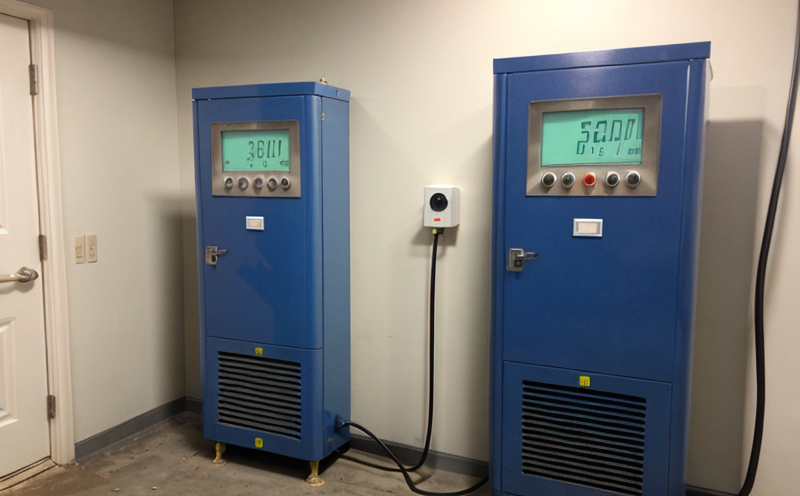DIN 20002 Methane Gas Safety Monitoring in Mines Testing
The DIN 20002 standard is a crucial guideline for methane gas safety monitoring within mines. This testing ensures that the levels of methane, one of the most potent flammable and explosive gases, are kept at safe thresholds to prevent accidents and ensure worker safety.
Methane can be generated from various sources in underground mining environments, including coal seams, natural gas deposits, and even the breakdown of organic matter. Given its high calorific value and potential for rapid combustion under certain conditions, methane poses a significant risk if not properly managed. The DIN 20002 standard provides comprehensive protocols to monitor methane levels accurately and reliably.
The testing process involves multiple steps designed to ensure precision and reliability. First, the mine environment is carefully surveyed to identify areas where methane may accumulate. This includes checking for potential leaks in gas pipelines or equipment, as well as natural sources of methane within the rock formations. Once identified, these areas are targeted for more detailed monitoring.
Sampling methods vary depending on the location and expected concentration levels. For instance, continuous monitoring systems might be installed near critical machinery such as coal cutters or conveyors to detect any sudden spikes in methane levels promptly. In contrast, portable gas detectors could be used by mobile teams who patrol different sections of the mine during routine inspections.
Once samples have been collected, they undergo rigorous analysis using specialized equipment that adheres strictly to DIN 20002 requirements. This typically involves gas chromatography or similar techniques capable of identifying trace amounts of methane accurately. The results are then compared against predefined safety thresholds specified by the standard. If levels exceed these limits, immediate action must be taken to address the issue.
Testing frequency depends on several factors including mine type (open pit vs underground), operational history, and current safety measures already in place. However, it is generally recommended that methane monitoring occur at least twice daily with additional checks during peak production hours when there are higher risks of accidents occurring due to increased activity levels.
The importance of this testing cannot be overstated given the severe consequences of an unchecked methane leak or explosion within a mine. Not only does it endanger human lives but also threatens property, disrupts operations, and leads to costly downtime. By adhering strictly to DIN 20002 guidelines, mines can significantly reduce these risks while maintaining efficient and safe working conditions.
In summary, the DIN 20002 standard offers a robust framework for methane gas safety monitoring in mines. It helps identify potential hazards early on through precise sampling techniques followed by accurate analysis of results against established criteria. Through regular testing and proactive measures based on these findings, mines can maintain a safer environment for all involved parties.
Why Choose This Test
The DIN 20002 Methane Gas Safety Monitoring in Mines Testing is an essential service that provides unparalleled peace of mind to those responsible for ensuring worker safety and operational continuity within mining operations. Here are several compelling reasons why choosing this test is advantageous:
Compliance with International Standards: Adherence to DIN 20002 ensures full compliance with internationally recognized standards, which helps avoid penalties associated with non-compliance. This is particularly important for businesses operating across multiple jurisdictions or exporting goods internationally.
Rigorous Testing Protocols: Our laboratory follows stringent testing protocols that ensure accurate and reliable results. This level of precision is critical when dealing with potentially hazardous materials like methane, where even small errors could have catastrophic consequences.
Expertise in Mining Applications: With years of experience serving the mining industry, our team understands the unique challenges faced by this sector. We tailor our testing processes to meet specific mine requirements, ensuring that you get actionable insights rather than generic data points.
Robust Data Analysis Capabilities: Leveraging advanced analytical tools and techniques allows us to provide detailed reports on methane concentrations throughout your facility. These insights enable informed decision-making regarding necessary safety improvements or operational adjustments.
Proactive Safety Measures: Regular testing helps identify potential issues before they escalate into full-blown emergencies. By detecting anomalies early, we allow mines to implement corrective actions promptly, thereby minimizing disruptions and ensuring continuous safe operations.
Enhanced Reputation Among Stakeholders: Demonstrating commitment to safety through rigorous testing enhances your reputation among stakeholders, including employees, investors, customers, and regulatory bodies. It shows that you take your responsibilities seriously and prioritize creating a secure working environment.
Economic Benefits: While the initial cost of implementing DIN 20002 may seem high, it ultimately proves to be an investment rather than an expense. By preventing accidents and related damages, reducing downtime caused by emergency shutdowns or evacuations, you can significantly lower overall operational costs.
In conclusion, selecting DIN 20002 Methane Gas Safety Monitoring in Mines Testing offers numerous benefits beyond mere compliance requirements. It contributes to a safer working environment, enhances your business reputation, and ultimately results in cost savings for yours operations.
Competitive Advantage and Market Impact
The implementation of DIN 20002 Methane Gas Safety Monitoring in Mines Testing provides significant competitive advantages and market impacts. In today's highly regulated environment, adhering to international standards such as DIN 20002 not only enhances safety but also sets you apart from competitors who may rely on less stringent practices.
Regulatory Compliance: By following DIN 20002 guidelines, mines demonstrate their commitment to regulatory compliance. This is particularly important in countries with strict mining regulations where non-compliance can lead to severe penalties. Staying ahead of these requirements helps maintain a favorable position in the market.
Enhanced Reputation: A strong safety record built on rigorous testing practices improves your company's reputation among key stakeholders, including employees, investors, and customers. This positive image fosters trust and loyalty, making it easier to attract top talent and secure long-term contracts.
Innovation Opportunities





